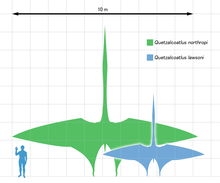Pterosaur size
Pterosaurs included the largest flying animals ever to have lived. They are a clade of prehistoric archosaurian reptiles closely related to dinosaurs. Species among pterosaurs occupied several types of environments, which ranged from aquatic to forested. Below are the lists that comprise the smallest and the largest pterosaurs known as of 2022[update].

Smallest pterosaurs
The smallest known pterosaur is Nemicolopterus with a wingspan of about 25 cm (10 in).[1] The specimen found may be a juvenile or a subadult, however, and adults may have been larger. Anurognathus is another small pterosaur, with a wingspan of 35 cm (14 in) and 40 g (1.4 oz) in body mass.[2], along with an indeterminate non-pterodactyloid pterosaur from the Portland Formation, although it is indeterminate and known from very fragmentary remains, only including a tooth, and part of the wrist bones.
Pterosaurs with largest wingspan

This is a list of pterosaurs with estimated maximum wingspan of more than 5
- Hatzegopteryx thambema 10–12 m (33–39 ft)[3][4][5]
- Quetzalcoatlus northropi 10–11 m (33–36 ft)[3][5]
- Cryodrakon boreas 10 m (33 ft)[5]
- Undescribed specimen from Mongolia 10 m (33 ft)[6][7]
- Thanatosdrakon amaru 9 m (30 ft)[8]
- Arambourgiania philadelphiae 8–9 m (26–30 ft)[5]
- Tropeognathus mesembrinus 8.26–8.7 m (27–29 ft)[9][10]
- Pteranodon longiceps 7.25–7.6 m (23.8–24.9 ft)[11][12]
- Thapunngaka shawi 6–7 m (20–23 ft)[13]
- Alanqa saharica 6 m (20 ft)[14][5]
- Santanadactylus araripensis 5.7 m (19 ft)[15]
- Cearadactylus atrox 5.5 m (18 ft)[15]
The largest of non-pterodactyloid pterosaurs as well as the largest Jurassic pterosaur[16] was Dearc, with an estimated wingspan between 2.2 m (7 ft 3 in) and 3.8 m (12 ft).[17] Only a fragmentary rhamphorhynchid specimen from Germany could be larger (184 % the size of the biggest Rhamphorhynchus).[18] Other huge non-pterodactyloid pterosaurs are Sericipterus, Campylognathoides and Harpactognathus, with the wingspan of 1.73 m (5 ft 8 in),[19] 1.75 m (5 ft 9 in),[19] and 2.5 m (8 ft 2 in),[18] respectively. Middle Jurassic Angustinaripterus had a wingspan of 1.6 m (5 ft 3 in).[20]
Speculation about pterosaur size and flight

Some species of pterosaurs grew to very large sizes and this has implications for their capacity for flight. Many pterosaurs were small but the largest had wingspans which exceeded 9 m (30 ft). The largest of these are estimated to have weighed 250 kilograms (550 lb). For comparison, the
Factors such as the warmer climate of the Mesozoic or higher levels of atmospheric oxygen have been proposed but it is now generally agreed that even the largest pterosaurs could have flown in today's skies.[21] Partly, this is due to the presence of air sacs in their wing membranes,[22] and that pterosaurs launched into flight using their front limbs in a quadrupedal stance similar to that of modern bats, a method faster and less energy taxing than the bipedal launching of modern birds.[23][24]
See also
- List of pterosaur genera
- Timeline of pterosaur research
- Smallest organisms
- Largest prehistoric animals
- Dinosaur size
References
- PMID 18268340.
- ^ Witton, M.P. (2008) "A new approach to determining pterosaur body mass and its implications for pterosaur flight". Zitteliania B28: 143-159
- ^ a b Witton, Mark P.; Martill, David M.; Loveridge, Robert F. (2010). "Clipping the Wings of Giant Pterosaurs: Comments on Wingspan Estimations and Diversity". Acta Geoscientica Sinica. 31 (Supp 1): 79–81.
- PMID 28133577.
- ^ S2CID 249332375.
- S2CID 134424023.)
{{cite journal}}: CS1 maint: multiple names: authors list (link - ^ "Ancient Winged Terror Was One of the Largest Animals to Fly". 31 October 2017. Archived from the original on 30 March 2019.
- S2CID 248140163. Retrieved 12 April 2022.
- PMID 23538956.
- PMID 23794925.
- ^ Bennett, S.C. (1994). "The Pterosaurs of the Niobrara Chalk". The Earth Scientist. 11 (1): 22–25.
- S2CID 128801077– via ResearchGate.
- .
- PMID 20520782.
- ^ ISBN 0-7607-0154-7.
- ^ "Fossil of largest Jurassic pterosaur found on Skye". BBC News. 22 February 2022. Retrieved 22 February 2022.
- Wikidata Q110984418.
- ^ a b Spindler, Frederik; Ifrim, Christina (2021). "Die Spur einer Spur – ein möglicher erster Flugsaurier aus Ettling Trace of a trace – a putative first pterosaur from the Ettling locality". Archaeopteryx. 37: 75–83.
- ^ S2CID 53688256. Archived from the original(PDF) on 31 July 2021.
- ^ Wellnhofer, 1991
- ISBN 0691150613.
- PMID 19223979.
- ^ Fox, Stuart (May 1, 2009). "How Giant Pterosaurs Took Flight". Scientific American. Retrieved July 11, 2014.
- ISBN 0691150613.
External links
- "Czech article on DinosaurusBlog". 28 April 2009. Archived from the original on 16 November 2021.
